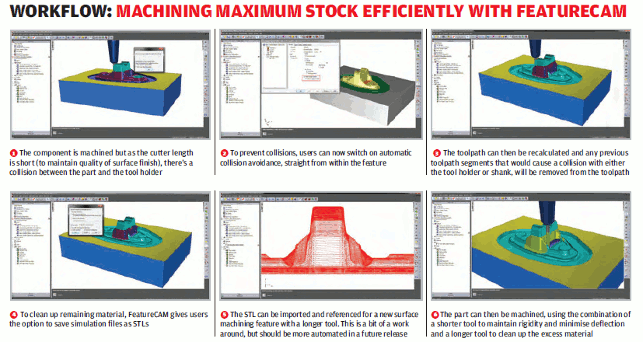Delcam built its reputation on tackling the tough, complex end of the CNC programming market with its PowerMill application.
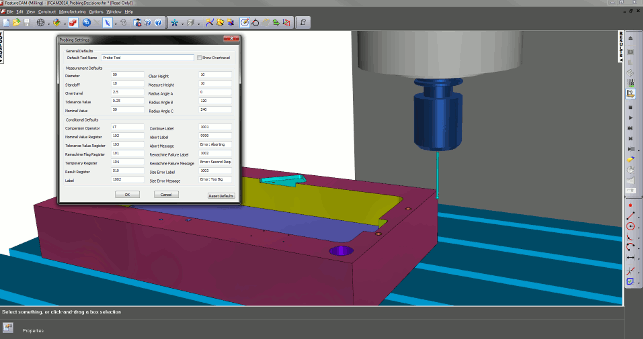
FeatureCAM now includes tools to integrate probing operations into NC code. This can then be used to build logic to measure, then remachine if the geometry is not found to be within tolerance
While this has remained the company’s bread and butter, acquisitions over the years have seen it bring software in house that looks to tackle the less complex — in terms of more prismatic geometry — end of the spectrum. One of those systems is FeatureCAM.
If you’ve not come across FeatureCAM, it’s been built up over Delcam’s 20 year history to allow a user to jump into CAM and G-code creation from a very low level and progressively move to more sophisticated parts and equipment. The name itself might be rather misleading for those used to working with CAM systems solely built around feature recognition.
Rather, the Feature in FeatureCAM refers to its ability to create machinable features from very little information. For example, it’s perfectly possible to create a series of features (holes, pockets etc.) by defining the sizes and locations of those features, using interactive tools, from pretty much a napkin sketch or rudimentary CAD drawing.
But of course, we’re now in the age where 3D CAD files are prevalent and FeatureCAM’s capabilities have expanded to include not only the import and repurposing of 3D CAD geometry, but Delcam has also been working on updating and expanding the system’s functionality in terms of not only the range of machining processes it supports (it now covers from 2.5D and lathe work through 3- and 5-axis into the realms of mill/turn), but also the intelligence with which it can drive the part programming process.
As it has been a while since we last looked at FeatureCAM, we’ll take a look at the highlights over the last couple of major releases. FeatureCAM is still on a pretty aggressive release schedule, with three major updates each year, plus monthly service packs.
Probes and measurement
One area that’s seen some rework is the integration of probing sequences directly into the system, rather than relying on the user adding the appropriate G-code in manually.
These new tools allow you to program in a measuring task, extract the measurement, then build in the logic required to act on that information.
You define where the probe is held (in terms of tool number and offset), where measurements are taken on the part and then store the information.
You can then, for example, use that information to kick off a re-machining process if the feature you measured is out of tolerance.
Jig & fixture avoidance
One of the key challenges of any part programming process is not only ensuring that you’re machining the component correctly, but also that you’re avoiding any jigs and fixtures as well as ensuring that these are in the optimum position.
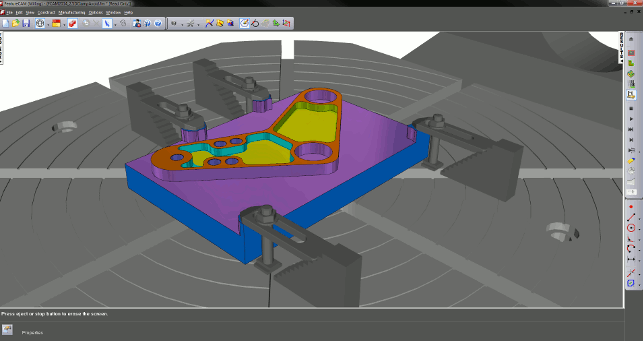
FeatureCAM now includes automatic avoidance of jigs and fixtures. This is automated in the toolpath generation process and gives you an input for clearance
In releases before FeatureCAM 2013, you could ensure that there were no collisions or gouges between your cutter and fixtures; the later releases take this a step further.
During the programming process, you define which geometry represents jigs, fixtures, clamps or vices and the system incorporates this information into the tool-path creation.
The system will then actively avoid those parts (by a defined clearance) and adapt the toolpath around them where possible.
If part features can’t be reached, it’s clear at a much earlier stage, so you can adjust machining parameters, such as cutter length, or just move the fixtures to an alternate position.
Vortex machining
One of the biggest changes since Delcam acquired FeatureCAM and its developers is that the company has been working to bring across some of its more advanced machining strategies from PowerMill.
This release continues this work and it sees the implementation of the Vortex area clearance strategy. If you have read our latest review of Powermill, you’ll probably be up to speed with this, but it’s worth a quick recap.

FeatureCAM also includes Vortex operations to allow full flute cutting and maintaining cutter engagement angle
The Vortex strategy is Delcam’s take on a trend that’s happening across the CAM world of late that focuses on roughing with solid carbide cutters at near full flute depth. The challenge centres on maintaining a constant engagement angle, between your cutter’s surface and your stock.
This allows you to maintain feed-rates over an entire tool-path. By controlling those two factors, you can then rip into the material at larger step-downs than would traditionally be the case, because the system is looking to ensure you’re doing it intelligently.
While Vortex has considerable benefits when working on 3-axis parts, the same levels of time saving can also be seen on 2.5D toolpaths.
Automatic collision avoidance
We’ve detailed this in our workflow below, but the idea centres on the age old issue that part cavities are often deep and require a long cutter, but optimal cutter conditions are when you’re running with a shorter cutter length to maintain accuracy by minimising deflection.
The new Automatic Collision Avoidance function allows you to remove any segments of a toolpath that would cause a collision with the tool shank or holder. Any material remaining can then be machined with a longer tool.
Part mirroring
This is a curious one. It’s often the case that you have to manufacture handed sets of components. They have exactly the same geometry, just flipped across an axis of symmetry.
Using a traditional workflow, both parts (left and right hand) would need to be programmed individually, doubling the time to get the part on the machine.
FeatureCAM now supports mirroring of parts right from simple 2.5 to 3 + 2 machining (at present, it doesn’t work for turning and 5-axis). The geometry is, obviously, mirrored, but so are the toolpaths.
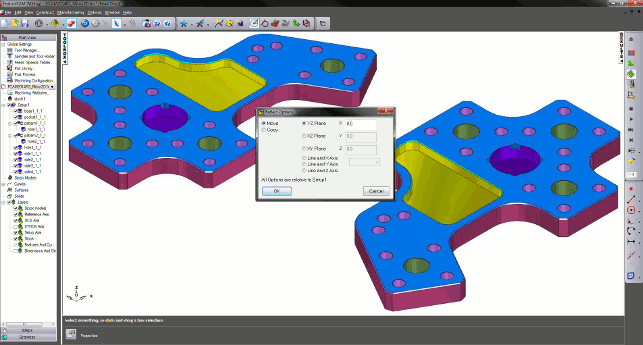
Part mirroring is more intelligent. Geometry is now mirrored, but toolpaths are maintained in the correct orientation, enabling quick machining of ‘handed’ components
What’s key, however, is that the direction of cut isn’t mirrored, rather it’s maintained as defined in the original.
So when you climb mill a left-handed part, the toolpaths adjust so that you’re also climb milling the right-hand variant as well.
Mill/turn updates
As we’ve established, FeatureCAM has for some time been centred on production machining, where the focus is on getting the part programmed, on the machine and shipped to the customer in the shortest time possible.
While this is still the case, the recent releases have seen support for more advanced machining processes and new tools introduced into the system.
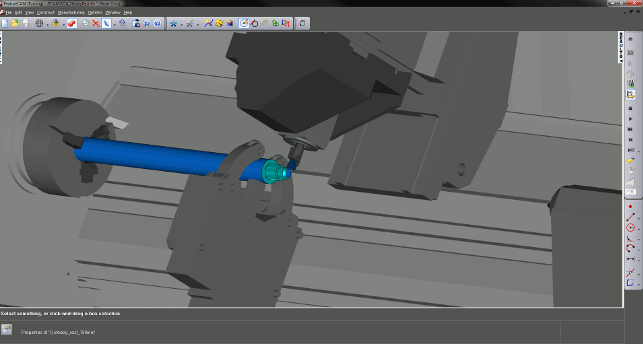
Mill/turn capabilities have been dramatically expanded over the last few releases. This latest update adds support for articulated B axes, multiple part catchers and steady supports
One such area is turn/mill and the main focus for FeatureCAM 2015 in this area is the addition of support for steady rests, tail stocks and part catchers.
These can now be automatically added not only into the NC code (which previously would have been a manual process), but also in the simulation process.
When you’re dealing with turn/mills at the more complex end of the spectrum, these types of tools and the ability to simulate their movement accurately is fundamental.
Conclusion
FeatureCAM is an interesting beast. Its roots are undoubtedly in production machining but its development is following the trends in the machining world at large.
While many machine shops might have stuck with 3-axis machining for the majority of their work, today’s shops are looking to increase their capability and equally, increase their throughput.
Combined with the lowering costs of more advanced machine tools, particularly in the 5-axis and turn/mill world, it’s a rich time for those looking to invest in their future.
Of course, while the investment in new machining capability is one thing, the flip-side is that the capex equipment purchase requires that those responsible for programming those machines also need investment, both in terms of the software required to drive them efficiently, but also in terms of training.
By expanding FeatureCAM’s capabilities beyond 3-axis machining and lathe work, this learning process is eased.
The newer, more complex machines can be programmed without learning vast new swathes of software. Only the new modules have to be learnt, rather than starting from scratch.
We’re seeing more re-shoring of machining than in the last two years and that means that there are a lot of folks looking to update their CAM capabilities.
So while older plant will continue to be used, newer techniques need to be learned and implemented in NC code.
FeatureCAM stands to make the most of this, both for existing customers as well as new ones. It starts, cost effectively, with the basic tools, then lets you grow your CAM system as you grow your knowledge and capability.
| Product | FeatureCAM 2015 |
|---|---|
| Company name | Delcam |
| Price | on application |


